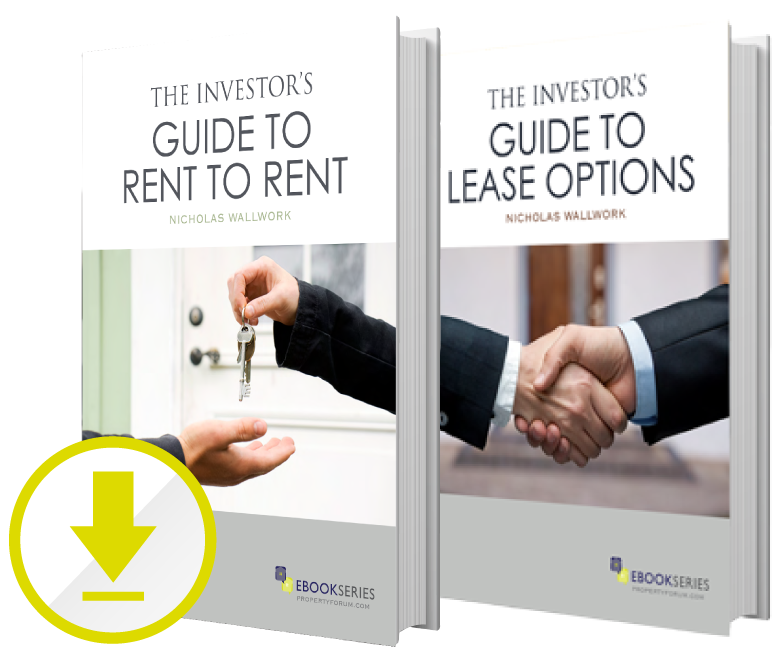Email: info@propertyforum.com
Rent-to-Rent and Lease Options
If you would like to learn how to build a successful HMO portfolio, you are in the right place. Download our free ‘Guide to Investing in HMOs’ to get started, then use the wealth of resources on this page to learn more, including videos, HMO news articles, HMO mentorships and much more.

Chat in our forum for free!
There are two different branches of property investments in the rental market: lease options and rent-to-rent. These investment strategies are easily confused, but from reading this guide, you will soon understand their differences.
Owning an asset is key for investors. Most people, therefore, assume that you need to buy a property to make money from it. But this is not the case. For many, purchasing an additional property is not a viable option when there are steep property prices, a lack of capital and fast-moving markets. However, there is still money to be made with a rent-to-rent strategy.
With the private rented sector accounting for £1.5 trillion of the overall UK property market, it is by far the fastest growing property sector in the country. In a rent-to-rent investment, you don’t need to own the property to capitalise from the rented sector. Instead, you can rent a property and then sublet the property to another tenant. If you are short on capital, a rent-to-rent is a great away to learn the property ropes, manage your tenants and, ultimately, make some money.
A specialist form of property management
Within a rent-to-rent, you have the responsibility of finding and managing your tenants. With your landlord’s permission, you can sublet the property on to your tenants, and this is where your profits lie.
In order to maximise your profit margins, it is advised with a rent-to-rent to change the use of the property. Here in the UK, this type of multi-tenant agreement doesn’t necessarily qualify as an HMO (House in Multiple Occupation). A well-managed HMO can also produce a tidy monthly profit — find out more and check out our guide into HMOs here.
Subletting on a room-by-room basis to long-term tenants is much more profitable than subletting the property as a whole. A typical example of this is student accommodation where properties are located in the surrounding areas of Universities.
Another option, with just as lucrative profit margins, is subletting the property as a whole but for short-term lets only. Using a management system such as Airbnb, you can determine a nightly rental price and target the corporate market. By applying a short-term rental model, or renting out individual rooms, your rent-to-rent strategy will reap more rewards.
This property investment strategy is an excellent way for first-time investors to enter the property market as rental properties do not require a lot of startup money. They are a sizeable low-capital strategy, which provides you with a monthly income from a property you don’t need to own.
If you are looking to expand your property portfolio experience, rent-to-rents are an accessible way to get more experience under your belt of managing tenants and maximising the property’s rental income. Moreover, a rent-to-rent property investment strategy is easily scalable. Many rent-to-rent investors go on to look after multiple properties as a full-time business.
For a property owner, a rent-to-rent agreement is also appealing as they get a hands-off way to earn money from their property.
It is important to note, despite this being a hands-off agreement for a property owner, you will be managing the property intensely. Whether you choose to sublet the property to multiple tenants, or as a whole in short-term lets, you will need to put in plenty of time and effort.
Just to be clear, we are not advocating illegal subletting. Rent-to-rent strategies, with your landlord’s permission, is not about cramming as many tenants into a property as you can. Treat your rent-to-rent property as a reputable and ethical business. You are the service provider, your landlord a stakeholder and, of course, your tenants are your valued, paying customers.
You should also be aware that in rent-to-rents, as you are renting the property, it is the landlord that benefits from any capital growth on the property. There is also the risk that the landlord could choose to sell their property, which would mean you would have to move your tenants on. A lease option, however, removes this risk and offers you more security, read on to find out more.
Rent-to-rent strategies are a great introduction to property investments. There is no need for vast injections of capital. It allows anyone with an entrepreneurial spirit, people skills and a strong work ethic the option to learn about the property market and catch the property bug without having to make a purchase.
Covering Startup Costs
It is possible to set up a rent-to-rent with almost no upfront costs. To do this, you’ll need to work quickly and negotiate a ‘hard deal’ with your landlord. It will be a challenge, but it is doable. For example, you can always negotiate a small upfront security deposit, with the rest of the deposit due later. This delay enables you the time to find your first tenants and get their security deposits.
Download our free ebook for more information on Rent-to-Rent investment strategies.
Lease options also referred to as rent-to-buy strategies, are another form of low-capital strategy for investors. This property investment strategy provides the possibility of future capital growth that a rent-to-rent agreement cannot. Capital growth is where the two branches of lease investment differ.
Similar to rent-to-rent strategies, in lease options, you rent a property from a landlord and then sublet it out to earn an income. Their main difference lies in the contracts. In a lease option, you negotiate the option to buy this property in the future. This agreement with the property owner is written into your contract. By arranging to purchase the property, you are not only benefiting from a steady income from subletting, but there is also the potential for capital growth in the future.
Upon first hearing about lease options, these strategies can come across as quite complicated and, consequently, can put off first-time investors. This should not be the case. If you are relatively new to property investments, lease options offer an accessible way into the market. With limited capital, you can gain valuable experience managing a property and tenants through lease, all the while having the guarantee of owning a property further down the line.
The most appealing benefit of rent-to-rent strategies is that it enables you to start earning money very quickly. They are a great advantage to investors as there is no need to purchase a property or secure a mortgage. Instead, you can earn a steady monthly income through subletting, which many use towards completing the purchase of the property further down the line. Unlike rent-to-rent strategies, you are also able to cash in on the capital growth that your hard work influences.
In some lease options, it is possible to agree on a purchase price at the time you sign the lease option agreement. Negotiating the purchase price in advance could secure you a great deal, assuming the property continues to increase in value.
It is true that if you are looking to enter a lease option, these properties, or these property owners, may take longer to find. And, once found, will require some careful negotiation skills. However, if you have the time to browse and identify the right opportunity, the rewards are very much worth the effort.
The most significant risk with lease options is if the property owner defaults on their mortgage repayments and pockets your monthly rent. If the property has to be repossessed, you will lose your monthly income and the chance to purchase the property in the future. There are ways to increase your security. We advise that you have it written into your contract that the property owner supplies you with regular mortgage statements to prove they are keeping on top of their payments.
Another possibility is that the owner defaults on the lease option, meaning they would refuse to sell you the property. This situation is an extremely rare turn of events and, unless you want to pay the legal fees, you will have to be prepared to walk away.
The one catch with lease options can be having to negotiate with a property owner that this strategy is beneficial for both of you. You may be surprised, but lease options can be attractive to a property owner.
During your tenancy, your rent to them will be paying off their mortgage. And, all the maintenance and outgoings of the property standing empty will come to you or, more specifically, your sublet tenants. For the property owner, the longer their property stands empty the more money it costs them. Moreover, unique to a lease option, they would have also secured a sale for the future. So, a guaranteed rental income in the short-term and a lump sum later on when the sale is completed.
By allowing you to sublet the property, you are taking away their hassle of finding tenants and dealing with breaks in the tenancy. The only person the property owner needs to concern themselves with is you; you will be taking on the sole responsibility and management of the tenants. Similarly, if the property owner has been paying an independent company to manage their tenants, they will no longer require this service, and this will be another financial saving.
Remember, by matching the right strategy to the right circumstances is vital. When selecting your property, keep in mind the landlord’s circumstances, would they be looking to sell in the near future? It has been estimated that one in four landlords are thinking of selling within the year, making now the time to negotiate your lease option.
For more advice in identifying lease option opportunities as well as the ins and outs of the lease option financial model, download our free ebook today. Don’t forget we also have another ebook dedicated to rent-to-rent strategies, to help answer any questions that you may still have. Alternatively, join the conversation with other investors, landlords and professionals on our online forum.
Have you considered a Rent-to-Rent or Lease Options mentorship?
Most people who live in an HMO enjoy the communal aspect of living and you can make some great friends this way, as well as paying lower living costs than you would renting alone. In general, as there are more people in an HMO property, wear and tear can be more intense and so repairs and replacements may be required more often.
Read the latest news articles on Rent-to-Rent and Lease Options...
Watch hours of property investment strategy tips with our Chat Show...
Most people who live in an HMO enjoy the communal aspect of living and you can make some great friends this way, as well as paying lower living costs than you would renting alone. In general, as there are more people in an HMO property, wear and tear can be more intense and so repairs and replacements may be required more often.
Learn more about other property investment strategies...

Lorem ipsum dolor sit amet, consectetur adipiscing elit. Ut elit tellus, luctus nec ullamcorper mattis, pulvinar dapibus leo.

Lorem ipsum dolor sit amet, consectetur adipiscing elit. Ut elit tellus, luctus nec ullamcorper mattis, pulvinar dapibus leo.

Lorem ipsum dolor sit amet, consectetur adipiscing elit. Ut elit tellus, luctus nec ullamcorper mattis, pulvinar dapibus leo.

